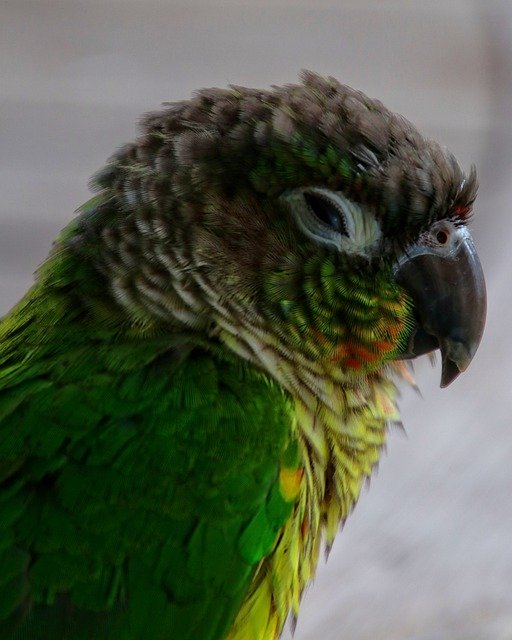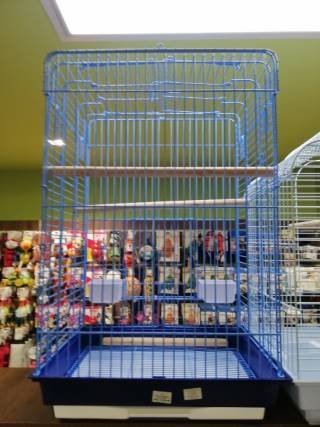The Pineapple Conure, a stunning variation of the Green Cheek Conure, is the result of a mutation between the Cinnamon and Yellow-sided Conures. In this comprehensive guide, we’ll explore everything about Pineapple Conures—from their unique physical traits and personality to their diet and care requirements, ensuring you can provide the best possible environment for these vibrant and social birds.
Table of Content
- Pineapple Conure Color
- Gender Differences
- Behavior
- Talking Ability
- Breeding
- Cage Requirements
- Diet
- Training
- Lifespan
Pineapple Conure Physical Attributes
Understanding the physical attributes of Pineapple Conures is essential when deciding whether to bring one into your home. Factors such as size, color, and ease of handling play a significant role in making this decision. Let’s explore the key physical characteristics of Pineapple Conures:
Size and Weight
Pineapple Conures are among the smaller Conure species, making them a great choice for bird enthusiasts seeking a manageable pet. Adults typically measure around 10 inches in length and weigh between 60 and 80 grams, combining compact size with a lively personality.
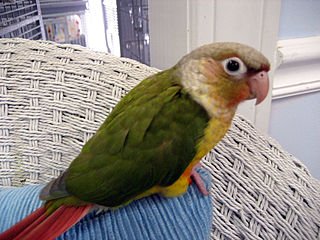
Pineapple Conure Gender Differences
Visually, male and female Pineapple Conures are almost identical, making it challenging to distinguish their sexes based on appearance alone. Some owners report behavioral differences, with males often being slightly more assertive or adventurous and females displaying nurturing behaviors during nesting. However, these traits are not universal, as individual personalities can vary widely. In some cases, females may even become territorial, particularly around nesting areas.
Pineapple Conure Color
Since Pineapple Conure is a mutation of Cinnamon and Yellow-sided Conure, the colors of both these mutations are dominant in the Pineapple Conures. They feature a tan-colored head and yellow sides. Their back feathers showcase a lime green color just like a Cinnamon Conure and the chest is full of bright red and yellow colors.
A reddish-orange color is usually seen around their lower beak feathers. Also, some hints of red can be seen above their cere. The tail feathers range from light red to maroon just like Yellow-sided Conures and display a halo effect. Their eyes are ruby red similar to Cinnamon Conures.

Pineapple Conure Behavior
Green Cheek Conures are among the quietest Conure species and can even be kept as pets in an apartment. These birds are highly social and thrive on interaction with their owners, often forming strong bonds and enjoying regular playtime.
They are curious and intelligent, eager to explore their surroundings and engage in activities like foraging, climbing, and even learning simple tricks. While generally not as noisy as other parrot species.
Pineapple Conures can still be vocal when excited or seeking attention. Their playful antics, such as rolling on their backs, hanging upside down, and mimicking sounds, provide endless entertainment. However, without enough mental stimulation and social interaction, they can become bored or even develop behavioral issues, such as biting or feather plucking. It’s essential for owners to provide a stimulating environment with plenty of toys, attention, and affection to keep these vibrant little birds happy and healthy.
Their small size does not restrict them from behaving like their bigger cousins, the Macaws. With a similar clownish personality, Pineapple Conures can entertain people for hours. They are very active and carry out extremely funny antics including dancing, shaking, kissing, and hanging upside-down.
If proper attention is not provided, these birds are known to develop behavioral issues and become quite aggressive. This can lead them to stress and depression. The condition needs to be addressed immediately in such a case.
Temperament
The temperament of Pineapple Conure is a bit relaxed and fun-filled. They are extremely interactive and full of life which is evident from their playful behavior. They do not come across as true Conures for their quiet nature, making them perfect for people looking to own a Conure for their personality traits but aren’t ready to bear the loudness.
Being clownish is their second nature. They have a unique way of shaking and dancing to entertain people around them adding to everyone’s amusement. Though Pineapple Conures have some individual personality differences, they all become aggressive if not given enough cuddles. They usually want their owners to rub their neck, tummy, and head. In return, these little birdies climb through their owner’s hair and pockets to snuggle close to them.
Since Pineapple Conures are quite energetic throughout the day, their excessive energies must be directed toward their favorite activity: playing. These clowns of the bird world love to hang upside down and can do that without getting bored. So, a good variety of ropes will keep them amused. A good variety of toys offered to Pineapple Conures will prevent the occurrence of any behavioral issues.
Pineapple Conure Talking Ability
Pineapple Conures are not that great talkers. Their talking abilities can be compared to Parrotlets as they both are generally quiet but can learn a few words. Since their voice is quite rough and deep-sounding, they are not the best birds to develop talking abilities. Though their vocabulary will remain limited, they will put in efforts to mimic some human speech if encouraged well. Their love for human interaction helps them learn to talk when their owners spend enough time teaching them. This ability, however, varies widely between individual birds. Some will learn more while others not.
Pineapple Conure Lifespan and Aging
Pineapple Conures have a lifespan that typically ranges from 15 to 30 years in captivity, with proper care and a balanced diet. They reach maturity around 1 to 2 years of age, at which point they are fully grown and begin to display adult behaviors. Breeding age usually begins at about 1 to 3 years, with females sometimes maturing slightly earlier than males, though it’s best to wait until they are at least a year old to allow for full physical and emotional development.
As they enter their senior years, typically around 20 years and beyond, Pineapple Conures may show signs of aging, such as a decrease in energy, changes in feather quality, or a more relaxed temperament.
To calculate a Conure’s age in “human years,” a general rule of thumb is to consider one bird year as roughly equivalent to 4-5 human years. This means a 2-year-old Conure is similar in maturity to a human in their early teens, while a 20-year-old Conure is comparable to a human in their 80s.
I have made an App that Calculates Conure Age to Human Age here
Pineapple Conure Breeding
To successfully breed Pineapple Conures, start by ensuring both the male and female are healthy, fully mature (at least 1 to 3 years old), and have formed a bond. Provide a spacious cage in a quiet, comfortable environment, away from disturbances. Equip the cage with a wooden nesting box, measuring about 10x10x12 inches, and line it with soft bedding like pine shavings.
Before breeding, enhance their diet with extra nutrients, particularly calcium-rich foods, to support egg production. Gradually increase daylight hours to mimic the breeding season, usually spring to early summer. Once mating occurs, the female will lay a clutch of 4 to 6 eggs, which both parents will incubate for about 22 to 25 days. Ensure a steady supply of fresh food and water during this period to support the parents’ needs. After hatching, the chicks will be ready to fledge at around 8 weeks old.

The breeding season for Pineapple Conures is summer in their natural habitat which coincides with February. In captivity, Pineapple Conure owners might observe some breeding behavior during this period. The females tend to start hiding in the nest box more often. Both genders can be seen regurgitating food to each other and nipping the other below the middle-back. All these signs indicate mating readiness in Pineapple Conures.
Pineapple Conure Cage Requirements
With their small size, Pineapple Conures do not require as much space as many large parrot species might require. But, looking at their playful nature, a 22 to 24-inch square cage with a height of about 30 inches would do well for these creatures. Keeping a space of ½ to ¾ inch in the metal bars is best for these cages. Such flight cages are comfortable for the Pineapple Conures and provide them with adequate room for physical activity.
Adding cage accessories to any bird’s cage is a necessity. Pineapple Conures have a curious and joyful nature and might get bored without the addition of accessories.
Different size perches
Conures live in forests with many options to perch. Moving around through the forest and landing on different branches helps them strengthen their grip. They also have the ability to choose comfortable places to rest. Inside the cage, they are limited to the resting places you provide. So, adding perches of different lengths and varying thicknesses will keep the Pineapple Conure both physically and mentally fit. The main aim of installing perches of varying shapes and sizes is to enhance the bird’s flexibility, strengthen its grip, and provide a comfortable resting place.

Not only is the selection of perches important, but their placement in the cage also plays an important role in keeping the Pineapple Conure amused for a long. These perches must be installed at an appropriate distance so that the little bird can take small to medium flights comfortably. Choosing a non-toxic wood material for making these perches is necessary to prevent any harm to the Pineapple Conures if they try to chew them.
Installing one sturdy perch will allow the Pineapple Conure to wipe his beak after having food. This resembles the act of Pineapples in the wild that helps them grind their beak naturally. Installing some soft chewable perches in the cage is also important for the same reason. Brushing against the toenails of Pineapple Conure shall also be installed for naturally grinding them off. Depending on how comfortable the individual pet bird feels, a pattern of perches can be created.
Feeding Bowls
Adding food and water bowls to the Pineapple Conure’s cage is extremely essential. Water, seeds, fruits, and vegetables are a must for every bird. So, feeding bowls to fulfill all these needs must always be there inside their cage. Since Pineapple Conures are quite active all the time due to their playful character, their metabolism is very fast. This calls for filling up their feeding bowls as soon as they finish them off or having a backup bowl of each of them, in case the first one goes empty. These feeding bowls can either be kept inside the cage or hung on the cage bars with the help of clippers.

The water bowl should be filled up with filtered water. It must be filled afresh every time to provide clean drinking water to the bird. Fruits and vegetables should be served in chopped, diced, sliced or pureed form to the Pineapple Conures. Since fruits and veggies might go bad if kept open for long, the bowl should be removed if the pet bird does not consume it fully.
Supplements
Unlike in the wild, Pineapple Conure does not get all the essential nutrients in captivity. It, therefore, becomes important to supplement their diet with nutrients and minerals to keep them healthy. The most appropriate way to feed them all the left-out nutrients is to fill their cage with mineral blocks. Many high-quality mineral blocks can be found in the market that contain all the nutrients in a perfect mix.
Additionally, adding cuttlebone to the Pineapple Conure’s cage is a must for fulfilling his calcium needs. This not only keeps his beak conditioned but also makes his bones strong and healthy. A cuttlebone holder can be installed in the cage to keep it stable while the bird chews upon it.
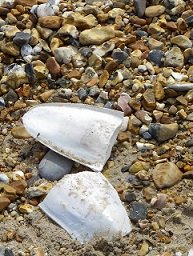
Pineapple Conure Toys
Like other species of parrots, Pineapple Conures also need entertainment. Toys can be a good source of entertainment for these birds and can also help in physical and mental stimulation. Lack of toys will make Pineapple Conures dull, both physically and mentally. This makes him lose interest in life and fall into depression. Hence, the addition of toys in his cage is a must.
A wide variety of toys are available in the market for Pineapple Conures like rope-like hanging toys, swings of varying shapes, sparkly toys with mirrors and bells on them, and small wooden ladders with eye-catching patterns. All these toys interest these little birds a lot. With an inquisitive personality, Pineapple Conures also love to find hidden treats by unwrapping or dismantling the toys, so foraging toys can also be added to their cages. These mentally stimulating toys keep their minds occupied and they are less likely to get bored or fall into depression
.
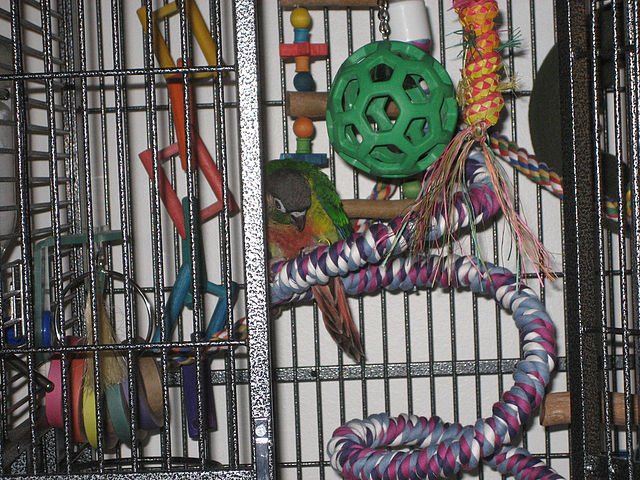
Not everyone can spend on market toys and it is not at all necessary either. Home-made toys are equally good for Pineapple Conures and can be personalized by the bird owners. Snake-like swings, soft wool-ball toys with mirrors and sparkles, and foraging toys with hidden nuts as a treat can be easily created at home. Ensuring that all the toys, whether market-made or home-made, are made from non-toxic material and colors.
Pineapple Conure Diet
As with any other parrot species, diet is important for the good physical and mental health of Pineapple Conures. They have a varied diet that needs to be balanced for optimum nutrition.
Pineapple Conure Diet in Captivity
While in captivity, Pineapple Conures eat what they are served. Hence, it becomes the responsibility of the owner to feed the bird a balanced diet.
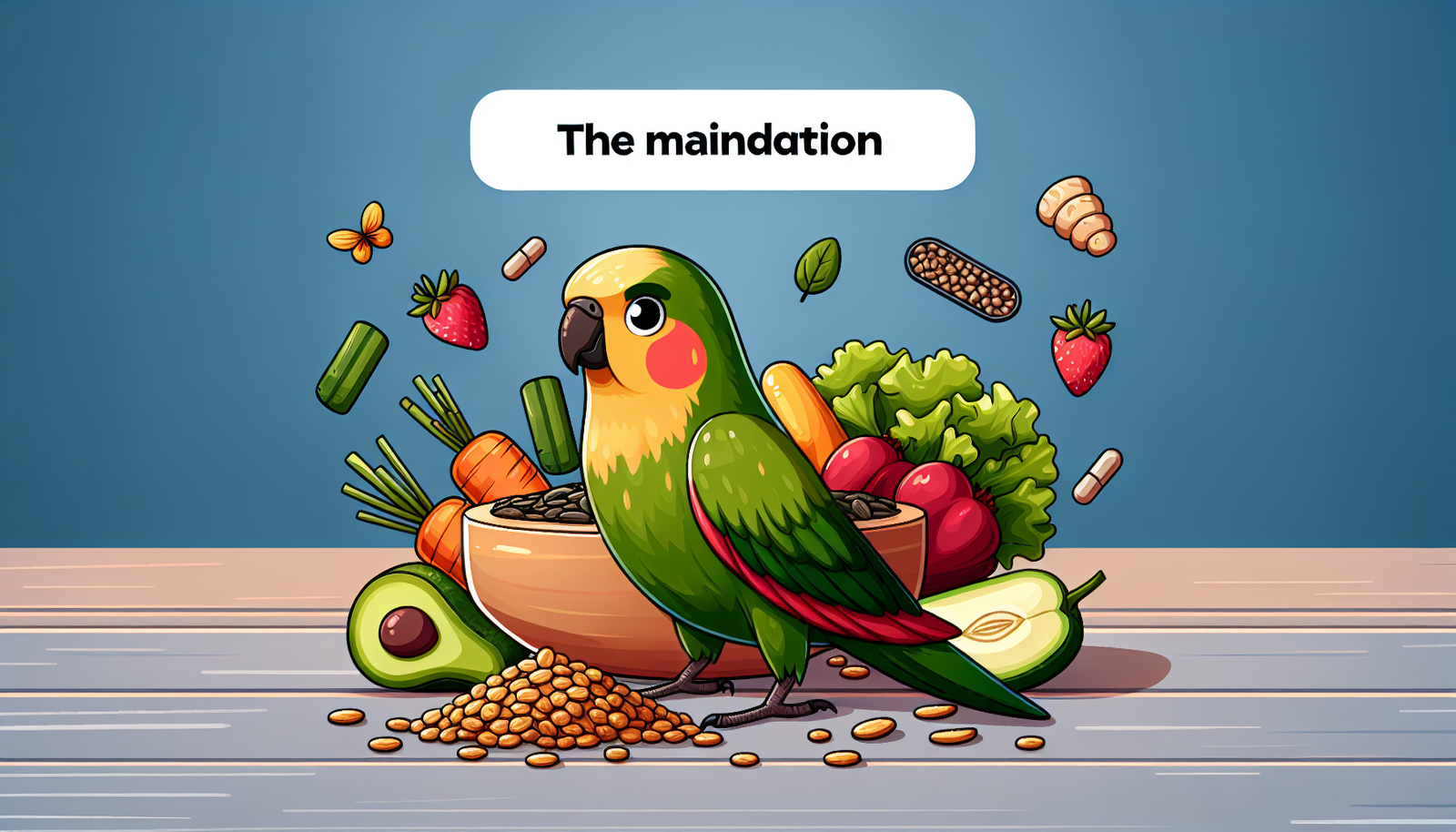
Seeds are the favorite of Pineapple Conures and they love gorging on a variety of them. Feed them quinoa, chia, and barley, or mix a few of them to keep the bird interested. Soak them for a few hours before serving to make them chewable for the bird. Or you can also serve them sprouted if the bird likes. Try not to overdo the seeds as they are high in fat content and might cause obesity in Pineapples. Also, try not to feed the market-made seed mix to the bird as it contains high fat content along an imbalanced nutrition profile.
Pellets form the major portion of Pineapple’s diet and account for roughly 65-70% of his diet. They are important because they contain everything that the bird lacks in his daily diet. Loaded with a balanced nutrition profile pellets are a must for Pineapple. Select a high-quality brand available online or at any pet store.
Fruits are another favorite of Pineapples in the wild as well as in captivity. Serve them a variety of fresh fruits like bananas, apples, grapes, pineapples, berries, blueberries, mangoes, pears, etc. These can be offered with or without peel. Slice them, dice them, or puree them before serving. The key is to keep them manageable for the bird to eat. Discard all the fruits kept uneaten for more than 5-6 hours. These might have grown germs.
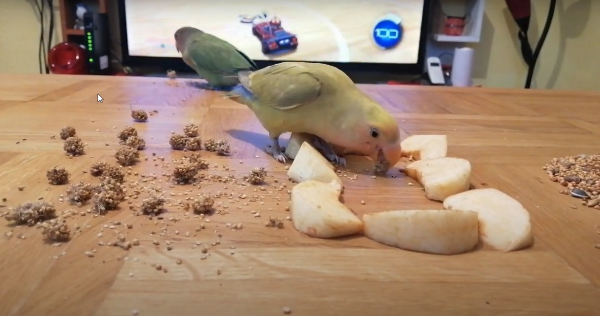
Vegetables are the major source of greens for the Pineapple Conure while in captivity. Offer them collard greens, beet greens, kale, or watercress along with some spinach to add some calcium to their feed. Apart from the leafy greens, dark vegetables are a great way to fulfill the bird’s Vitamin A requirements. Serve them sweet potatoes, pumpkin, or winter squash in small bite-sized pieces.
Freshwater is a must to keep Pineapple Conure hydrated, especially in hot and humid weather. Keep the supply of fresh water regularly at all times of the day. And during hot months, it is best to keep a backup feeding bowl for the bird, in case the first one runs out of supply. Serve only clean drinkable-quality water. Keep changing the water every few hours to maintain hygiene.
Cuttlebone is a must to keep parrot bones strong and healthy. The best way is to hang the cuttlebone inside his cage near a perch so that it is easy for him to chew it whenever he likes. This would add up as a beak-grinder for the bird and keep his beak in shape.
Food that is not good for Pineapple Conure. Besides obvious chocolate, salty, and artificially sweetened food, make sure your bird doesn’t nibble on in-house plants. Here is a list of some toxic plants on Wikipedia.
Getting New Pineapple Conure Home
When buying a new bird owners are normally excited and in a hurry to socialize their bird as soon as possible. The first couple of days are very important in getting your Pineapple conure tame and friendly. Your new bird will have different behavior depending on where did you got it from. Also, younger birds can be trained more easily than mature birds.
Pineapple Conure Training
If you got Pineapple Conure from a breeder who hand-fed it, you will have a much easier job. You can start working with your bird as soon as it gets accustomed to a new home. It might be a couple of hours only. You can just continue Hand feeding it, give it millet seeds by hand, or if the parrot is still young, you can make a baby parrot food mix, and feed it from the syringe. Normally these young parrots will have trouble flying at the start, make sure you secure your home before letting them out of the cage for the first couple of times until they get accustomed to your home.
If you got your Pineapple Conure from the shop, it will take much longer for your bird to get your trust. Depending on how your bird is handled in the shop Taming can last any time from a month to a year. The key to this process is patience. Start by spending as much time next to the cage as possible, talk to your parrot, and make sure it gets comfortable next to you. Then slowly start giving your bird treats from your hand (some birds love millet seeds as a training treat). At first through cage bars, then after you see the bird is getting comfortable you can slowly open the cage door and feed Pineapple Conure from your hand. Move really slowly If you notice your Conure gets startled, slowly move away.
Pineapple Conure like all parrots are social animals, and they tend to spend time with other parrots. If you have a single parrot it is just a matter of time before they will consider you part of the flock. Also, they are smart animals and every bird will have individual personalities. Sometimes it can take even a year to socialise with the new Pineapple Conure. You can check my experience with Lovebird in the video below. But I also had parrots that got tame in a day or two.
Summing Up
Pineapple Conures make excellent companions with their playful and affectionate nature. By understanding their needs and providing a nurturing environment, you can ensure a happy and healthy life for your feathered friend. If you have any questions or experiences with Pineapple Conures, feel free to share them in the comments below!
Published: April 15, 2020
Last Updated: August 22, 2024

